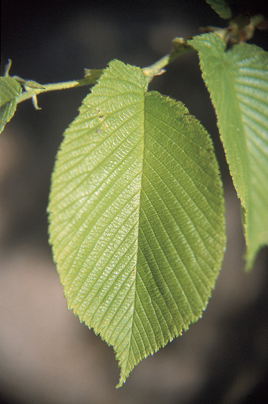Elm
Genus of flowering plants in the family Ulmaceae
Elms are deciduous and semi-deciduous trees comprising the flowering plant genus Ulmus, in the plant family Ulmaceae. The genus first appeared in the Miocene period about 40 million years ago, originating in central Asia. These trees have spread across the Northern Hemisphere, from North America to Europe and Asia.
Description[edit]
Elms are known for their distinctive vase-like shape and their serrated leaves. The leaves are typically arranged in two rows along the branches and are simple, with an asymmetrical base and a doubly serrated margin.

The flowers of the elm are small and inconspicuous, appearing in early spring before the leaves. They are wind-pollinated and form in clusters. The fruit is a samara, a type of winged seed that is dispersed by the wind.

Species[edit]
There are about 30 to 40 species of elms, with the most notable being:
- Ulmus americana - American Elm
- Ulmus glabra - Wych Elm
- Ulmus rubra - Slippery Elm
- Ulmus minor - Field Elm
- Ulmus parvifolia - Chinese Elm

Distribution and Habitat[edit]
Elms are found in a variety of habitats, including riverbanks, floodplains, and forests. They are adaptable to different soil types and climates, which has allowed them to spread widely across the Northern Hemisphere.
Uses[edit]
Elms have been used for various purposes throughout history. The wood is valued for its strength and resistance to splitting, making it ideal for furniture, flooring, and boat building. Elm bark has also been used in traditional medicine.
Diseases[edit]
Elms are susceptible to several diseases, the most notorious being Dutch elm disease, caused by a fungus spread by bark beetles. This disease has devastated elm populations in Europe and North America.
Conservation[edit]
Efforts are underway to conserve elm species and develop disease-resistant varieties. Breeding programs have produced hybrids such as Sapporo Autumn Gold that show resistance to Dutch elm disease.

Related pages[edit]
Ad. Transform your life with W8MD's Budget GLP-1 injections from $75


W8MD offers a medical weight loss program to lose weight in Philadelphia. Our physician-supervised medical weight loss provides:
- Weight loss injections in NYC (generic and brand names):
- Zepbound / Mounjaro, Wegovy / Ozempic, Saxenda
- Most insurances accepted or discounted self-pay rates. We will obtain insurance prior authorizations if needed.
- Generic GLP1 weight loss injections from $75 for the starting dose.
- Also offer prescription weight loss medications including Phentermine, Qsymia, Diethylpropion, Contrave etc.
NYC weight loss doctor appointmentsNYC weight loss doctor appointments
Start your NYC weight loss journey today at our NYC medical weight loss and Philadelphia medical weight loss clinics.
- Call 718-946-5500 to lose weight in NYC or for medical weight loss in Philadelphia 215-676-2334.
- Tags:NYC medical weight loss, Philadelphia lose weight Zepbound NYC, Budget GLP1 weight loss injections, Wegovy Philadelphia, Wegovy NYC, Philadelphia medical weight loss, Brookly weight loss and Wegovy NYC
|
WikiMD's Wellness Encyclopedia |
| Let Food Be Thy Medicine Medicine Thy Food - Hippocrates |
Medical Disclaimer: WikiMD is not a substitute for professional medical advice. The information on WikiMD is provided as an information resource only, may be incorrect, outdated or misleading, and is not to be used or relied on for any diagnostic or treatment purposes. Please consult your health care provider before making any healthcare decisions or for guidance about a specific medical condition. WikiMD expressly disclaims responsibility, and shall have no liability, for any damages, loss, injury, or liability whatsoever suffered as a result of your reliance on the information contained in this site. By visiting this site you agree to the foregoing terms and conditions, which may from time to time be changed or supplemented by WikiMD. If you do not agree to the foregoing terms and conditions, you should not enter or use this site. See full disclaimer.
Credits:Most images are courtesy of Wikimedia commons, and templates, categories Wikipedia, licensed under CC BY SA or similar.
Translate this page: - East Asian
中文,
日本,
한국어,
South Asian
हिन्दी,
தமிழ்,
తెలుగు,
Urdu,
ಕನ್ನಡ,
Southeast Asian
Indonesian,
Vietnamese,
Thai,
မြန်မာဘာသာ,
বাংলা
European
español,
Deutsch,
français,
Greek,
português do Brasil,
polski,
română,
русский,
Nederlands,
norsk,
svenska,
suomi,
Italian
Middle Eastern & African
عربى,
Turkish,
Persian,
Hebrew,
Afrikaans,
isiZulu,
Kiswahili,
Other
Bulgarian,
Hungarian,
Czech,
Swedish,
മലയാളം,
मराठी,
ਪੰਜਾਬੀ,
ગુજરાતી,
Portuguese,
Ukrainian